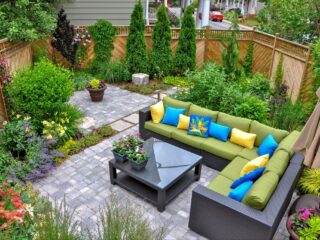
Transforming your yard into an eye-catching, low-maintenance oasis starts with choosing the right elements. You can incorporate drought-tolerant plants and native species to make your landscape thrive with minimal watering. Ground covers like creeping thyme help suppress weeds and retain moisture, while mulch enriches the soil and blocks sunlight from unwanted growth. Hardscaping elements such as pathways and patios not only reduce lawn wear but also add structure and visual interest. To simplify upkeep even further, automated irrigation systems can guarantee your garden stays lush without constant attention. Ready to explore how these ideas can revamp your outdoor space?
Choose Drought-Tolerant Plants
Selecting drought-tolerant plants is a smart way to create a beautiful garden that requires minimal watering and upkeep. You’ll not only save time and money, but you’ll also contribute to water conservation.
Start by choosing plants known for their resilience in dry conditions. Succulents, like agave and sedum, store water in their leaves, making them perfect for arid climates. Lavender and rosemary are great options too; they thrive in low-water environments and add a lovely fragrance to your garden.
When planning your garden, think about grouping plants with similar water needs. This practice, known as hydrozoning, guarantees that each plant receives the appropriate amount of water without wasting resources.
Mulching is another essential technique. A layer of mulch helps retain soil moisture, reducing the need for frequent watering.
Don’t forget about soil preparation. Well-draining soil is vital for drought-tolerant plants. You can improve drainage by adding sand or organic matter to your soil mix.
Finally, consider installing a drip irrigation system. It delivers water directly to the plant roots, reducing evaporation and guaranteeing efficient water use.
With these tips, you’ll create a lush, low-maintenance garden that’s both eco-friendly and stunning.
Opt for Native Species
When planning your garden, opting for native species can greatly reduce maintenance while promoting local biodiversity.
Native plants are well-adapted to your region’s climate, soil, and pests, making them hardier and less reliant on fertilizers and pesticides. Plus, they provide essential habitat for local wildlife, from bees to birds.
Here are four reasons why you should choose native species for your landscaping:
- Easier Care: Native plants have evolved to thrive in your local conditions, meaning they typically require less water, fertilization, and overall care compared to non-native species.
- Pest Resistance: These plants are naturally resistant to local pests and diseases, which means you’ll spend less time and money on chemical treatments.
- Environmental Benefits: By planting native species, you’re supporting the local ecosystem. These plants provide food and shelter for native insects and animals, helping to maintain biodiversity.
- Aesthetic Appeal: Native plants offer a unique beauty that reflects your region’s natural landscape, giving your garden an authentic and cohesive look.
Mulch for Weed Control
Complementing your choice of native species, using mulch is a highly effective strategy for controlling weeds while enhancing soil health and moisture retention.
Mulch acts as a barrier that prevents sunlight from reaching weed seeds, which inhibits their growth. Spread a two to three-inch layer of organic mulch like wood chips, bark, or compost around your plants. This not only keeps weeds at bay but also enriches the soil as it decomposes, adding essential nutrients.
Don’t forget to replenish the mulch annually to maintain its effectiveness. Various types of mulch offer different aesthetic and functional benefits. For instance, shredded bark provides a natural look and decomposes slowly, making it a long-lasting option. Pine needles are another excellent choice, especially if you have acid-loving plants like azaleas or blueberries.
When applying mulch, make certain you leave a small gap around plant stems and tree trunks to prevent rot. This simple step enhances your landscape’s visual appeal and supports plant health.
Install Automated Irrigation
Installing an automated irrigation system can considerably reduce the time you spend watering your garden while guaranteeing your plants get the consistent moisture they need to thrive. This system allows you to set specific watering schedules tailored to your landscape’s needs, giving you more time to enjoy your beautiful yard rather than maintaining it.
To get started, consider these essential steps:
- Assess Your Yard’s Watering Needs: Different plants require varying amounts of water. Group plants with similar needs together to enhance your irrigation system’s efficiency.
- Choose the Right System: Drip irrigation and sprinkler systems are two primary options. Drip irrigation is excellent for targeted watering, while sprinklers are better for larger areas.
- Install a Timer: An automated timer guarantees your garden is watered at prime times, such as early morning or late evening, reducing water evaporation and conserving resources.

- Regular Maintenance: Periodically check for leaks and clogs in your irrigation system to ensure it’s functioning correctly and efficiently.
Use Ground Covers
Ground covers, such as creeping thyme or moss, can transform your garden into a lush, low-maintenance oasis by reducing the need for constant weeding and watering. These plant varieties spread across the soil, creating a dense mat that suppresses weeds and retains moisture. Not only do they cut down your garden chores, but they also add texture and color to your landscape.
To get started, choose ground covers that thrive in your climate and soil type. Creeping thyme, for instance, thrives in sunny spots and well-drained soil, offering a fragrant and floral carpet. Moss, on the other hand, prefers shady, damp areas and lends a serene, woodland feel.
Planting ground covers is straightforward. Clear the area of existing weeds, loosen the soil, and plant your chosen varieties about 12 inches apart. Water them well initially to help them establish. Once they’re settled, they require minimal care—occasional watering during dry spells and a light trim to keep them neat.
Incorporating ground covers not only simplifies your gardening routine but also boosts your home’s curb appeal. Their versatility and low-maintenance nature make them an excellent choice for any garden enthusiast looking to create a beautiful, hassle-free landscape.
Incorporate Hardscaping Elements
Transform your garden into a low-maintenance haven by incorporating hardscaping elements like pathways, patios, and retaining walls. These features not only add structure and aesthetics but also reduce the need for constant upkeep. By opting for durable materials such as stone, brick, or concrete, you enhance both functionality and beauty. Explore Cultivate’s landscaping projects portfolio to see inspiring examples of how hardscaping can elevate your outdoor space
Here’s how you can maximize curb appeal with hardscaping:
- Pathways: Create inviting walkways using pavers or gravel. They guide visitors and minimize grass wear, making your garden look neat and organized.
- Patios: Install a patio to extend your living space outdoors. Choose low-maintenance materials like stamped concrete or composite decking, which resist weathering and require minimal care.

- Retaining Walls: Use retaining walls to manage slopes and prevent soil erosion. Opt for natural stone or modular blocks, which are long-lasting and add texture to your landscape.
- Mulched Beds: Surround your hardscaped areas with mulched beds. Mulch suppresses weeds, retains moisture, and gives a polished look without the need for frequent maintenance.
Conclusion
With these low-maintenance landscaping tips, you’ll have your garden looking exceptional without breaking a sweat.
By choosing drought-tolerant plants, native species, and effective ground covers, you’re hitting two birds with one stone—beauty and ease.
Don’t forget mulch for weed control and automated irrigation for hands-off watering.
Adding hardscaping elements ties it all together, making your landscape both practical and stunning.
Ready to transform your curb appeal with minimal effort? Immerse yourself and watch your garden thrive!





